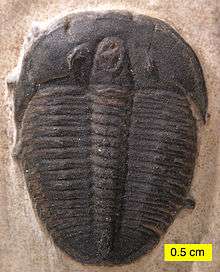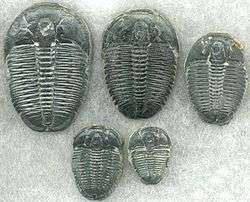Elrathia
| Elrathia Temporal range: Middle Cambrian | |
|---|---|
 | |
| Elrathia kingii | |
| Scientific classification | |
| Kingdom: | Animalia |
| Phylum: | Arthropoda |
| Class: | Trilobita |
| Order: | Ptychopariida |
| Family: | Alokistocaridae |
| Genus: | Elrathia Walcott, 1924 |
| Type species | |
| Conocoryphe kingii Meek, 1870 | |
| Species | |

Elrathia is a genus of ptychopariid trilobite species that lived during the Middle Cambrian of Utah, and possibly British Columbia. E. kingii is one of the most common trilobite fossils in the USA[1] locally found in extremely high concentrations within the Wheeler Formation in the U.S. state of Utah.[2] E. kingii has been considered the most recognizable trilobite.[3] Commercial quarries extract E. kingii in prolific numbers,[2] with just one commercial collector estimating 1.5 million specimens extracted in a 20-year career.[4] 1950 specimens of Elrathia are known from the Greater Phyllopod bed, where they comprise 3.7% of the community.[5]
"...trilobite occupied the exaerobic zone, at the boundary of anoxic and dysoxic bottom waters. E. kingii consistently occur in settings below the oxygen levels required by other contemporaneous epifaunal and infaunal benthic biota and may have derived energy from a food web that existed independently of phototrophic primary productivity. Although other fossil organisms are known to have preferred such environments, E. kingii is the earliest-known inhabitant of them, extending the documented range of the exaerobic ecological strategy into the Cambrian Period."— Gaines & Droser[2], 2003, p941
Etymology
Even though the generic name Elrathia was first published in the combination E. kingii, a species from the House Range Utah, the name, itself, is derived from Elrath, Cherokee County, Alabama.[6]
Description
E. kingii is a medium-sized trilobite with a smooth sub-ovate carapace that is tapered towards the rear. Thorax is usually 13 segments. Pygidium has four axial rings and a long terminal piece. Posterior margin of the pygidium has a long broad medial notch.
In contrast, E. marjum usually has 12 segments, 5 axial rings, lacks a notched posterior margin and possess incipient antero-lateral spines.[4]
The British Columbian species, E. permulta, is much smaller, averaging about only 20 millimeters, and has up to thoracic 14 segments. Because E. permulta lacks several diagnostic features of the genus, it may, in fact, represent a distinct genus.
Synonyms
Elrathia is variously known as Elrathina, which is in fact a separate genus sometimes considered to be a synonym of Ptychoparella, and the species E. kingii is often erroneously called E. kingi (with one i).
See also
External links
- "Elrathia permulta". Burgess Shale Fossil Gallery. Virtual Museum of Canada. 2011.
- "Elrathina cordillerae". Burgess Shale Fossil Gallery. Virtual Museum of Canada. 2011.
References
- ↑ Johnson, Kirk; Troll, Ray (2007). Cruising the fossil freeway: An epoch tale of a scientist and an artist on the ultimate 5,000-Mile paleo road trip. Golden, CO: Fulcrum Publishing. ISBN 978-1-55591-451-6.
- 1 2 3 Gaines, Robert R.; Droser, Mary L. (2003). "Paleoecology of the familiar trilobite Elrathia kingii: An early exaerobic zone inhabitant" (PDF). Geology. 31 (11): 941–4. doi:10.1130/G19926.1.
- ↑ Brett, C. E.; Allison, P. A.; Desantis, M. K.; Liddell, W. D.; Kramer, A. (2009). "Sequence stratigraphy, cyclic facies, and lagerstätten in the Middle Cambrian Wheeler and Marjum Formations, Great Basin, Utah". Palaeogeography Palaeoclimatology Palaeoecology. 277: 9–33. doi:10.1016/j.palaeo.2009.02.010.
- 1 2 Gunther, L.F.; Gunther, V.G. (1981). "Some Middle Cambrian Fossils of Utah". Brigham Young University Geology Studies. 28: 1–81.
- ↑ Caron, Jean-Bernard; Jackson, Donald A. (October 2006). "Taphonomy of the Greater Phyllopod Bed community, Burgess Shale". PALAIOS. 21 (5): 451–65. doi:10.2110/palo.2003.P05-070R. JSTOR 20173022.
- ↑ Resser, Charles Elmer (1938). Cambrian System (Restricted) of the Southern Appalachians. Geological Society of America Special Paper. 15. p. 77. ISBN 081372015X.